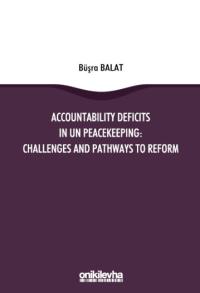Accountability Deficits in UN Peacekeeping: Challenges and Pathways to Reform
Büşra BALAT
İÇİNDEKİLER
Chapter 1: Introduction
1.1. Introduction and Overview
1.2. Notes on Terminology
1.3. Methodology
1.4. Chapter Overview
PART I
CONCEPTUAL AND THEORETICAL ANALYSIS OF UN ACCOUNTABILITY
Chapter 2: Conceptual Analysis of the United Nations and Accountability
2.1. Introduction
2.2. Conceptual Analysis of the UN
2.3. Conceptual Analysis of Accountability
2.4. Conclusion
Chapter 3: Examining the Accountability of the United Nations from Theoretical Perspectives
3.1. Introduction
3.2. Theories on the Status of the UN as an International Organisation
3.3. Significance of the Accountability of the UN's Global Governance Power
3.4. Conclusion
Chapter 4: Human Rights Perspective on UN Accountability
4.1. Introduction
4.2. Examining the Obligations of the UN Under International Human Rights Law
4.3. Human Rights in the context of UN Accountability
4.4. Interplay of Reparation, Justice and Accountability
4.5. Conclusion
PART II
OVERVIEW AND CRITICAL ANALYSIS OF EXISTING ACCOUNTABILITY REGIMES WITHIN THE FRAMEWORK OF UN PKOS
Chapter 5: Analysing Existing Accountability Frameworks and Identifying Accountability Gaps
5.1. Introduction
5.2. Accountability Standards for the UN
5.3. Accountability Standards for UN peacekeepers
5.4. Accountability 'for what': Analysing Articles on the Responsibilities of International Organisations
5.5. Examining Different Control Tests
5.6. Conclusion
Chapter 6: Assessing the Impact of UN Immunity on the Rights to Access Justice and UN Accountability
6.1. Introduction
6.2. Analysing the Impact of Immunity Rules on the Rights to Access Justice
6.3. Immunities and Privileges for UN Peacekeeping Actors
6.4. Obligation to Waive Immunity and Provide an Alternative Mode of Settlement as a Counterpart of Immunity
6.5. Assessing Immunity in Relation to Accountability: Implementation for UN PKOs
6.6. Conclusion
PART III
AN EMPIRICAL ANALYSIS OF THE IMPLEMENTATIONS OF THE EXISTING ACCOUNTABILITY FRAMEWORK
Chapter 7: A Case Study of Sexual Exploitation and Abuse in the Central African Republic
7.1. Introduction
7.2. Background Information: The Conflict in the CAR and the Mandate of MINUSCA
7.3. Allegations and Initial Responses
7.4. Understanding SEA in the Coercive Environment of the CAR
7.5. The Problems in Practice
7.6. The Risk of a Culture of Impunity
7.7. Conclusion
Chapter 8: Challenges in the Implementation of the Existing Accountability Frameworks
8.1. Introduction
8.2. Assessing Accountability Frameworks for Perpetrators and UN Officials in the CAR Case
8.3. Assessing the Implementation of the ARIO in the CAR case
8.4. Conclusion
Chapter 9: Conclusion and Recommendations
Appendix
Bibliography


